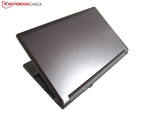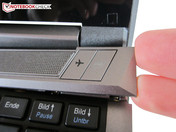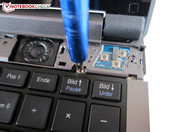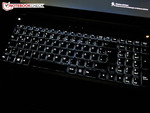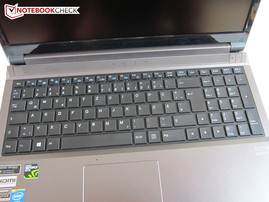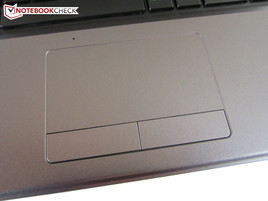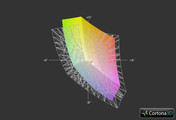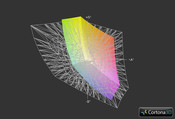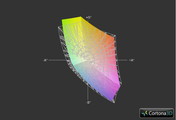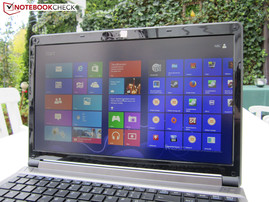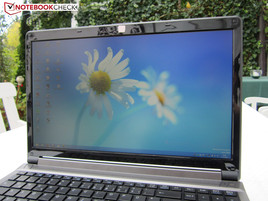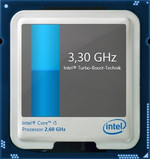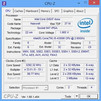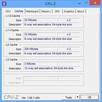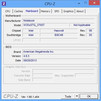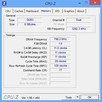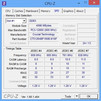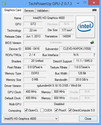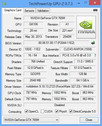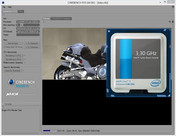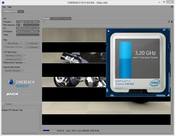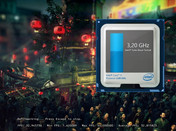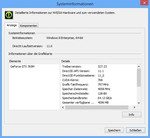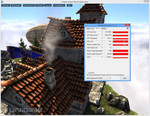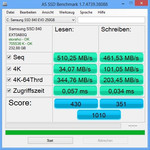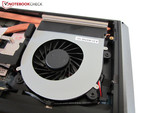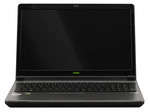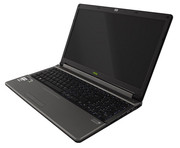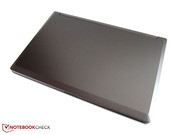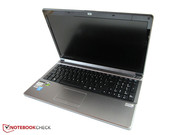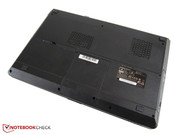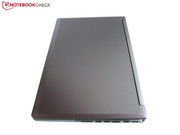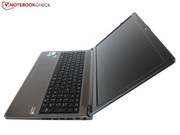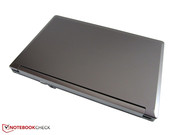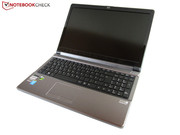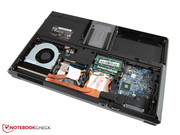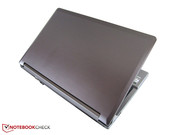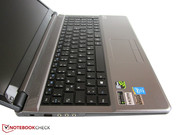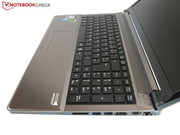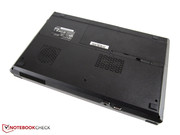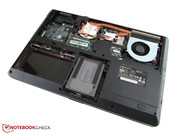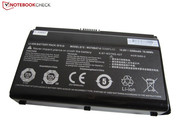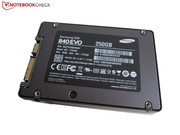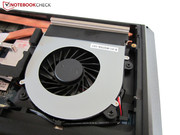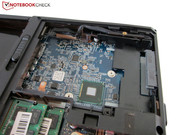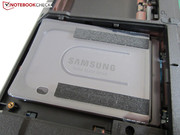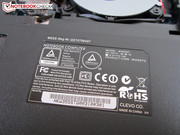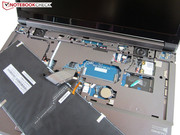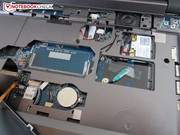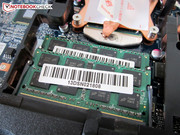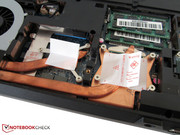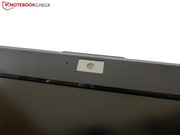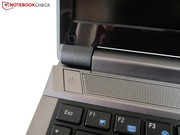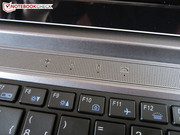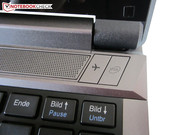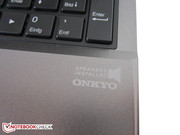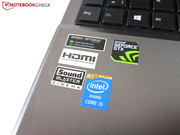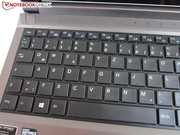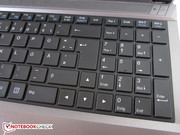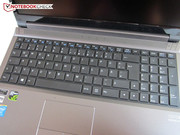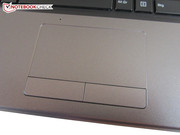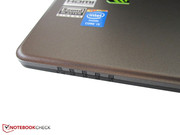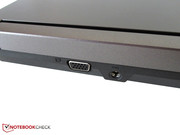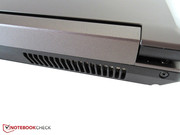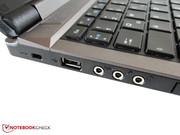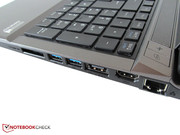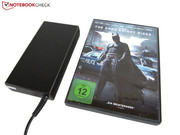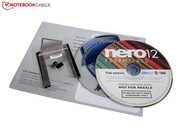Review Schenker XMG A503 (Clevo W355STQ) Notebook
For the original German review, see here.
The shear amount of high-end laptops currently available makes it harder than ever to stay on top of things, even in the smaller gaming segment. Those for whom a freely configurable system is paramount might have an easier time in choosing the right device. The German laptop maker Schenker Technologies is one of the few - and one of the best - companies in this market segment. And, as with its siblings, the brand-new XMG A503 can be customized individually on Schenker's website.
The 15.6-inch Full HD display can be had in both a glossy and a matte variant (optionally with an especially broad color space). Both dual-core and quad-core Intel Haswell CPUs are available, ranging from an affordable Core i5-4200M (2.5 to 3.1 GHz) to a prestigious Core i7-4900MQ (2.8 to 3.8 GHz). According to our own expectations - including those from this review - one of the cheaper variants should suffice for most users (no more than the Core i7-4700MQ).
Depending on the CPU, the A503 ships with up to 16 or 24 GB of RAM (three DDR3 memory banks are available). At least 8 GB of RAM are recommended to have some reserves for the future. Even more customization is possible in terms of storage: Conventional HDDs with up to 1.5 TB, hybrid models (so-called SSHs) and several SSDs can be chosen. Great: Thanks to two 2.5-inch drive bays and an additional mSATA slot, up to three hard drives can be used simultaneously (three with an ODD-Caddy).
The base model also includes an integrated DVD burner, but a Blu-ray drive is optionally available as well. Even the wireless modules can be customized (several Wi-Fi modems made by Intel and Qualcomm are available), as is the case for the keyboard layout. The laptop ships without any OS in order to keep the price of the base model down. Windows 7 or 8 cost extra.
Since we have already performed a number of reviews of the GeForce GTX 765M in tandem with a quad-core CPU (Alienware 14, Asus G750JW, MSI GE70, One K33-3E, among others), we have ordered a XMG A503 variant with a "mere" dual-core CPU. At the time of this writing, our test device (see specs on the right) could be had for roughly 1200 Euros (~$1642).
The XMG A503 does not sport the same chassis as its predecessor, but rather the W355ST barebones of the Taiwanese company Clevo which - apart from a few details such as the lack of a fingerprint sensor and a differently designed speaker bar - comes quite close to the W350ST barebones of the now-discontinued XMG A523.
Despite of the silverish-gray color of both the lid and the palm rest, the A503 sports an overall modest design with a conventional shape and boxy lines (which will not be to the liking of all gamers) leading to an unspectacular appearance. It also appears a bit chunky when compared to slimmer competitors such as the Razer Blade or the MSI GS70.
Still, this is no absurdly thick 15-inch brick. Its dimensions of 37.4 x 25.0 x 4.5 centimeters (~14.7 x 9.8 x 1.8 inches) are as average as its 2.7 kilograms (~6.0 pounds) of weight, keeping it rather mobile (the power adapter measures 147 x 75 x 27 millimeters/5.8 x 3.0 x 1.0 inches and weighs 466 grams/~1 pound).
In terms of build quality, the laptop comes out as a decent device, but not as a great one. Not only are all surfaces made from plastic, but also there are some minor issues such as a slightly protruding keyboard and some clearances or misalignments. This might or might not be a specific problem of our pre-series test device - after all, the laptop is not yet available commercially.
In terms of sturdiness (which should be final), we were quite satisfied with the base unit. The display, however, feels wobbly and comes with low torsion-resistance, as do many displays. The massive image errors that occur whenever pressure is applied to the panel are not as normal, though.
We cannot comprehend why Clevo decided in favor of a glossy display frame, attracting fingerprints, dust and scratches like crazy. After all, the A503's more expensive 15-inch siblings, the P150SM and the P157SM, sport a matte display frame.
Nonetheless, the chassis can be called a "solid" product. Most customers should be content with its build quality.
In contrast to the XMG A502, most of the ports of the XMG A503 are located on the right hand side (instead of the left hand side). Luckily, they are placed as close as possible to the rear end of the device so that fans of external mice should not experience too much hassle with the protruding cables, even when the Ethernet, eSATA and HDMI ports are all big used.
Four USB ports (three of which are USB 3.0) and three audio jacks (Line In, Line Out, S/PDIF) should be more than enough for most users. In addition, the XMG A503 ships with a card reader and a Kensington Lock as well as a VGA port which is useful to connect older external displays without digital signal input. Overall, the variety of connectivity options is one of the strong suits of Clevo's barebones.
Wireless Communication
Those who want to save a little bit of money might be content with sticking to the base version, the often-used Centrino Wireless-N 2230, which sports support for Bluetooth 4.0, "Smart Connect" and "Wireless Display" while lacking in terms of dual-band functionality (it only comes with support for the 2.4 GHz band). The maximum data transfer rate is 300 Mbit/s, according to Intel.
In terms of effective range, the Centrino Wireless-N 2230 was neither the best nor the worst modem. 1-3 bars of Wi-Fi signal strength 15 meters (~49 feet) away from the router (with several walls in between) are decent, but the optionally available competitors offer more.
Maintenance
Maintenance is another strong suit of the XMG A503. While the smaller maintenance hatch beneath the device hides the primary 2.5-inch drive bay, the larger one hides the fan system, the CPU, the GPU, two memory banks and another 2.5-inch drive bay. The cooling system is completely accessible and can even be removed, if need be.
In order to access the third RAM slot and the mSATA slot, the keyboard has to be removed (see photos). The GPU cannot be swapped as the GeForce GTX 765M is fixed to the mainboard.
Software
In contrast to a number of competitors, Schenker refrains from installing unnecessary tools and bloatware, removing the need to uninstall a lot of applications.
Accessories
There is not a lot to write home about in this section. Apart from a driver DVD, a short user guide and a little bit of hard drive tools (like screws), there is only a Nero 12 Essentials DVD in the box. Otherwise, the laptop just ships with its power adapter (120 Watts) and its 8-cell battery (weighing 426 grams/~0.9 pounds).
Warranty
All customers who live in Germany get two years of pickup & return service (including six months of instant repair service), while only bring-in service is included abroad. For 100 or 200 Euros (~$137 or $274), respectively, a warranty extension to 36 or 48 months can be purchased.
Keyboard
Fortunately, the chiclet-style keyboard takes up almost all of the available width of the device, allowing for large keys (~15 x 15 millimeters) as well as a full-fledged numpad with four columns. The layout feels very reasonable, even sparing us from a "castrated" return button as it is found in the case of the XMG P703, the P723 and the W503.
Typing feels rather nice, both the pressure point and the keystrokes are well defined. The crisp typing experience is boosted by the large (approx. 3 millimeters) clearances between the keys - leading to fewer typos - as well as quieter typing. We would not have complained about rounded off corners, though.
The F keys allow (via key combinations) for a number of special controls, like increasing or decreasing the brightness and the volume as well as activating or deactivating the touchpad, the display, the webcam, the wireless modem and the two-step backlighting system. The latter is the main improvement in comparison to the W350ST-Barebones. However, those who are keen on another color rather than white (or several, differently colored zones) will have to look at other devices.
Touchpad
Qualitatively, the touchpad is not quite on par with the keyboard. On our test device, Schenker omitted the installation of the correct drivers so that no multi-touch support was included (more about the gestures can be found in our review of the XMG A523).
Apart from this, the touchpad works decently, although it could be better in terms of both precision and gliding properties. It is also rather average in size (93 x 50 millimeters/~3.7 x 2.0 inches, more or less the typical value for a 15-inch device). The dedicated mouse buttons are a bit on the ramshackle side, but again, this is rather common for most laptops. Since the touchpad has been lowered into the chassis, it can rather easily be found even in darkness.
High-end laptops that lack a Full HD display are getting harder and harder to sell, especially for gamers. The XMG A503 stays true to this trend, offering a native resolution of 1920x1080 pixels. Our test device comes with the matte standard variant that is - quite in contrast to the more expensive Gamut version - incapable of yielding decent color space rendition levels. Close to 50% of the AdobeRGB color space and 75% of the sRGB color space should be sufficient for most casual gamers, but still these are not great specs.
| |||||||||||||||||||||||||
Brightness Distribution: 89 %
Center on Battery: 367 cd/m²
Contrast: 798:1 (Black: 0.46 cd/m²)
ΔE ColorChecker Calman: 6.03 | ∀{0.5-29.43 Ø4.78}
ΔE Greyscale Calman: 6.12 | ∀{0.09-98 Ø5}
51% AdobeRGB 1998 (Argyll 1.6.3 3D)
52.9% AdobeRGB 1998 (Argyll 3D)
73% sRGB (Argyll 3D)
51.9% Display P3 (Argyll 3D)
Gamma: 2.62
CCT: 8211 K
The greatest strength of the CMN N156HG panel (the XMG A523 shipped with a dimmer LG Philips LP156WF1-TLF3 panel with quite a bad contrast ratio) is its superb maximum brightness: 365 cd/m² on average is much more than what most competitors offer.
Unfortunately, its black levels are not quite as good: 0.46 cd/m² lead to a slightly grayish appearance of black backgrounds. Deep blacks require 0.2-0.3 cd/m² or better. Still, despite this slight weakness, the overall contrast ratio comes close to 800:1 - a respectable result.
The display is not very well suited for professional graphic designers and similar people. Even though the CMN N156HG may be better than most of the competition (CalMAN grayscale, gamma and color accuracy values), it is still not good enough for any purpose which requires great color space rendition.
Some light bleeding occurred at the left and right hand sides of the display (these might not be a problem for all users). In addition, the pixel grid (fine lines) can actually be noticed easily even from further away.
Outdoor usage, on the other hand, is an area where the XMG A503 shines - literally. Its combination of a very high peak brightness and a matte finish lead to an almost perfect usability score, with almost no annoying reflections (especially indoors).
One of the disadvantages of the cheap TN technology is its mediocre viewing angle stability. While this is not a huge problem when talking about horizontal deviations, vertical viewing angle stability fares much worse. All things considered, the image quality feels about right given the price of this device, but a high-end display this is not.
Processor
Intel had already released its Haswell-based quad-core CPUs a few months back. Now it is time for a number of dual-core processors one of which is used in our test device: The Core i5-4300M is an attractive mid-range variant which might very well be the ideal companion to the GeForce GTX 765M.
The clock speed of 2.6-3.3 GHz of the 22nm-CPU allows it to remain approximately on par with the Core i7-4700MQ (2.4-3.4 GHz) when it comes to single- or dual-threading operations, even though the latter sports four cores and a lot more L3 cache (6 MB instead of 3 MB). The TDP - crucial for cooling purposes and the battery life of the device - has been reduced as well, from 47 Watts for the quad-core CPU to just 37 Watts. In terms of features, the smaller sibling does not have to hide: Both Turbo Boost (for automatic overclocking) and Hyperthreading (virtual doubling of the number of available cores) are on board here, too.
Since the laptop does support Nvidia's graphics switch protocol Optimus, only the integrated GPU is put to use while the A503 is idle or while simple tasks (MS Office, web, video etc.) are to be performed. The HD Graphics 4600 would actually even suffice for some less demanding games. When more raw performance is required, the GTX 765M gets activated - of course increasing power consumption and decreasing battery life in the process.
Turbo Boost
While the XMG A502 was not capable of making full use of its CPU Turbo Boost (it was deactivated under certain debatable conditions), the same does not hold true for the XMG A503. No matter whether we are talking about single-core or multi-core stress tests, we were always able to reach the maximum possible Turbo Boost clock speeds. As our screenshots show, the Core i5-4300M reached a plateau at 3.2-3.3 GHz (depending on the application): So, no more "Turbo holes" for Schenker.
CPU Performance
The exact performance levels of the Core i3-4300M depend primarily on the average utilization of its two cores - which depends strongly on the application in mind. During single-core tasks, it did not fall behind at all when compared to its quad-core brethren.
1.44 points during the single-threading test of Cinebench R11.5 is very close to the result of the Core i7-4702MQ (2.2-3.2 GHz, 1.44 points), used in the Acer Aspire V3-772G. The much more expensive Core i7-4700MQ and Core i7-4700HQ are barely faster (1.5 points and 1.52 points, tested with the Schenker XMG A523 and the Asus G750JW, respectively). Unsurprisingly, things look different when talking about the multithreading test: Even the Core i7-4702MQ beats the 3.47 points of the Core i5-4300M by more than 80%.
During real-life usage patterns in Windows, no significant differences can be noted. Standard tasks are no problem for the Core i5-4300M and even in more demanding applications, performance is almost never an issue so that price-sensitive gamers might want to opt for this CPU instead of a quad-core processor.
| Cinebench R10 | |
| Rendering Single CPUs 64Bit (sort by value) | |
| Core i5-4300M | |
| Core i7-4558U | |
| Core i7-4702MQ | |
| Core i7-4700MQ | |
| Core i7-4700HQ | |
| Rendering Multiple CPUs 64Bit (sort by value) | |
| Core i5-4300M | |
| Core i7-4558U | |
| Core i7-4702MQ | |
| Core i7-4700MQ | |
| Core i7-4700HQ | |
Graphics Card
Looking at the laptop market today, it seems that the GeForce GTX 765M must be one of the most successful high-end GPUs out there. Despite its more-than-decent performance levels, this is mostly due to its good value-for-money ratio.
Although both the GTX 770M and the GTX 780M are more potent GPUs, most manufacturers decide in favor of not only a cheaper, but also a less power-hungry graphics card which is thus also easier to cool. The GTX 765M's core and memory clock speed of 850 and 2000 MHz are on par with the values of its more expensive siblings, but the number of shader units has been reduced to 768 (960 in case of the GTX 770M, 1536 for the GTX 780M).
In addition, the memory interface has been cut back to 128-bit, despite its 2048 MB of GDDR5-VRAM. Still, the GTX 765M remains much faster than its mid-range siblings (the GT 750M, the GT 740M and the GT 730M) as well as the older GTX 660M (which sports a mere 384 CUDA cores). As with all Kepler generation GPUs, the GeForce GTX 765M has been manufactured using a 28-nm process.
In order to achieve the maximum possible performance levels, we have replaced the preinstalled (and outdated) GPU driver version 311.27 with the most recent ForceWare version 327.23. The standard driver would actually decrease a number of benchmark results (e.g. in GRID 2, Far Cry 3 and Hitman: Absolution).
GPU Performance
The most important question during our graphics and gaming tests has been whether there is a significant real-world difference between a dual-core and a quad-core system. To make it short: In most cases, there is barely any difference in terms of performance.
3DMark 2013 might be the best example for this: Using the brand-new WHQL driver, the XMG A503 can actually take the crown from other GTX 765M-based devices with a superior CPU, with 2518 points vs. 2385 points (One K33-3E, ForceWare 311.54) and 2366 points (MSI GE70, ForceWare 311.48).
The graphics-intensive Ungine Heaven 3.0 benchmark leads to a similar picture. With its native resolution of 1920x1080 pixels and tessellation set to "normal", the 15-inch laptop managed to yield 36.2 fps on average - a more-than-decent result, which would not have been better for a quad-core based laptop with the same GTX 765M (36.0 fps, Schenker W503).
| 3DMark Vantage - 1280x1024 P GPU no PhysX (sort by value) | |
| GeForce GTX 765M (327.23) / Core i5-4300M | |
| GeForce GTX 765M (311.54) / Core i7-4702MQ | |
| GeForce GTX 765M (311.27) / Core i7-4700MQ | |
| GeForce GTX 765M (311.27) / Core i7-4800MQ | |
| Unigine Heaven 2.1 - 1280x1024 high, Tesselation (normal), DirectX11 AA:off AF:1x (sort by value) | |
| GeForce GTX 765M (327.23) / Core i5-4300M | |
| GeForce GTX 765M (311.54) / Core i7-4702MQ | |
| GeForce GTX 765M (311.27) / Core i7-4700MQ | |
| GeForce GTX 765M (311.27) / Core i7-4800MQ | |
| 3DMark 06 Standard Score | 17589 points | |
| 3DMark Vantage P Result | 12922 points | |
| 3DMark 11 Performance | 4038 points | |
| 3DMark Ice Storm Standard Score | 74904 points | |
| 3DMark Cloud Gate Standard Score | 9207 points | |
| 3DMark Fire Strike Score | 2518 points | |
Help | ||
Storage Devices
Those who never grow tired of reducing boot and loading times close to non-existence should definitely purchase the SSD-variant of the XMG A503. Our test device shipped with a 250 GB Samsung SSD 840 EVO MZ-7TE250 (see pictures in the right hand column) which offers a lot of performance at a moderate price point.
Indeed, the SATA III model reaches superb transfer speeds during the AS SSD benchmark, with sequential read and write speeds of 510 MB/s and 462 MB/s, respectively. This is better than the 500 GB Crucial M500 (480 MB/s and 413 MB/s, Schenker XMG A523).
Including 4K speed results (for a large amount of small files), both SSDs come out approximately on par (overall score of ~1000 points). The same holds true for the access times of 0.03-0.06 ms in case of the 840 EVO and 0.05-0.07 ms for the Crucial M500.
The enormous speed of the SSD might also be due to the Turbo Boost mode that is capable of increasing SSD performance levels by up to 10% - as a second, slightly slower benchmark result directly after the first one showed.
System Performance
Despite its "mere" dual-core CPU, the XMG A503 manages to yield impressively high results during the system benchmarks. A PCMark Vantage score of 18,628 points comes to lie barely behind that of the quad-core-equipped Schenker XMG A523. Things look even better for the A503 when employing PCMark 7 (5720 points instead of 5944 points). Let us now have a look at the fps measurements during actual games.
| PCMark Vantage Result | 18628 points | |
| PCMark 7 Score | 5720 points | |
Help | ||
Gaming Performance
We are trying to look explicitly at titles which have been shown to be very CPU-sensitive during our review of the MSI GX70 (A10-5750M and Radeon HD 8970M). As expected, the GPU is usually the limiting factor in maximum settings. Thus, our demanding ultra setting was almost always handled every bit as well on the dual-core system as on a quad-core system (have a look at the table below the verdict).
Only after we reduced both the resolution (to 1366x768 pixels) and the quality settings (to "high"), did some games run 10 or even 20% slower on the dual-core machine (e.g. F1 2013, Total War: Rome II, Dota 2, GRID 2, Assassin's Creed III and Need for Speed: Most Wanted). With the notable exception of Guild Wars 2 (which loses 30%), no major disadvantages could be felt.
Still, the loss in terms of performance was far more pronounced for the MSI GX70 (mostly due to the worse efficiency of AMD's current mobile CPUs). Intel's processors rarely exhibit performance issues, even with full Turbo Boost. On average, according to our measurements, a dual-core processor should be slower by approximately 5% when compared to GTX-765M-based laptops with a quad-core CPU.
The upcoming generation of games will most likely be more demanding in terms of processing power due to the imminent launch of the Next-Gen consoles. Those who want to future-proof their system as much as possible might want to decide in favor of a quad-core CPU (or a laptop with an even faster GPU). Price-conscious gamers, however, will likely stick to the dual-core option.
| low | med. | high | ultra | |
|---|---|---|---|---|
| Battlefield 3 (2011) | 59.7 | 23.3 | ||
| The Elder Scrolls V: Skyrim (2011) | 63.3 | 34.9 | ||
| Max Payne 3 (2012) | 38.9 | 29.4 | ||
| Guild Wars 2 (2012) | 43.2 | 23.4 | ||
| Need for Speed: Most Wanted (2012) | 52.3 | 36.6 | ||
| Hitman: Absolution (2012) | 34.6 | 15 | ||
| Assassin´s Creed III (2012) | 59.2 | 22.8 | ||
| Far Cry 3 (2012) | 47.1 | 16 | ||
| GRID 2 (2013) | 84.2 | 35.4 | ||
| Company of Heroes 2 (2013) | 33.3 | 24.4 | 11.4 | |
| Dota 2 (2013) | 79.4 | 45.4 | ||
| Total War: Rome II (2013) | 86.2 | 15.9 | ||
| F1 2013 (2013) | 94 | 67 |
System Noise
Noise emissions: This is the area where the XMG A503 fares worst in terms of our ratings system. As is the case with other Clevo barebones, the fans get a lot louder during 3D applications than necessary.
During the 3DMark 06 benchmark, we measured 45 dB(A) during the first scene (from a distance of 15 centimeters/5.9 inches). Without a high-volume speaker system or headphones, this might very well be enough to drown music and sound effects alike. 49 dB(A) under full load? That is every bit as noisy as the XMG A523 was - apparently the lower power consumption levels of the dual-core CPU do not seem to factor into this equation.
While the device is idle, it remains perfectly silent at times, only to jump to 36-44 dB(A) without any apparent cause (allegedly, Schenker is already working on an update). In addition, the fans of our test device rattled a bit.
Bad luck or just a pre-sample? The first user reports will show. Anyway, we do hope that Clevo will put some more work into the fan control system - right now, it is far from perfect.
Noise level
| Idle |
| 29.3 / 30.2 / 36.3 dB(A) |
| DVD |
| 34.2 / dB(A) |
| Load |
| 45 / 48.6 dB(A) |
 | ||
30 dB silent 40 dB(A) audible 50 dB(A) loud |
||
min: | ||
Temperature
Most of the chassis only gets moderately warm. After two hours of being idle (maximum energy-saving profile), the outer temperature did not exceed approximately 28 degrees Celsius (82.4 Fahrenheit).
Even under full load, the XMG A504 did not reach uncomfortable levels. Around 34 degrees (93.2 Fahrenheit) on the top and 32 degrees (89.6 Fahrenheit) on the bottom of the device should not be an issue for anyone. Only the rear part of the device exceeded 40 degrees (104 Fahrenheit) during our stress test. We have to applaud the engineers when talking about the palm rest: It always remained at a very comfortable level of 24 to 25 degrees (75.2 to 77 degrees Fahrenheit).
While the XMG A503 does get a bit hotter than the XMG A523 (especially when talking about the A503's core temperature), this can be explained by the absence of throttling issues, with the A503 sticking true to its base clock speed instead of underclocking to 800 MHz.
According to the CPU-Z and Core Temp tools, the i5-4300M almost exceeded 100 degrees Celsius (212 Fahrenheit). The GeForce GTX 765M, on the other hand, stayed comparatively cool at around 76 degrees (168.8 Fahrenheit) thanks to its great design. Both the CPU and GPU tend to remain cooler during actual games compared to these stress test results.
(±) The maximum temperature on the upper side is 44.3 °C / 112 F, compared to the average of 40.4 °C / 105 F, ranging from 21.2 to 68.8 °C for the class Gaming.
(±) The bottom heats up to a maximum of 40.6 °C / 105 F, compared to the average of 43.3 °C / 110 F
(+) In idle usage, the average temperature for the upper side is 28.1 °C / 83 F, compared to the device average of 33.9 °C / 93 F.
(+) The palmrests and touchpad are cooler than skin temperature with a maximum of 25.2 °C / 77.4 F and are therefore cool to the touch.
(+) The average temperature of the palmrest area of similar devices was 28.9 °C / 84 F (+3.7 °C / 6.6 F).
Speakers
The speakers are another of the main weaknesses of the XMG A503. Despite the involvement of the audio experts from Onkyo, the sound quality of the 2.0 system is mediocre at best.
Almost all reference music, videos and games sound tinny and fuzzy. Bass is lacking, too, as are decent maximum volume levels. The audio quality gets even a bit worse once we deactivate the Sound Blaster Cinema technology.
Other competitors such as the Asus N550/N750, the Alienware 17 or the MSI GT70 sound better by a long shot. We highly recommend using a headset or external loudspeakers when listening to media for a long stretch of time.
Power Consumption
Since the GeForce GTX 765M only activates itself when it is truly needed, the laptop requires considerably less power than some of its competitors while idle: 15-25 Watts (which is close to the 15-26 Watts of our configuration of the XMG A523). Under load, as measured during 3DMark 06, this value increases to just 88 Watts (instead of 95 Watts for the XMG A523) thanks to the dual-core CPU. The difference grows to 25 Watts during the actual stress tests.
Overall, power consumption levels could be called average, somewhere between those of a potent multimedia device and an expensive luxury laptop.
| Off / Standby | |
| Idle | |
| Load |
|
Key:
min: | |
Battery Life
The A503's stamina is actually more than just decent considering this is a gaming laptop. Typical everyday activities such as DVD playback or browsing over Wi-Fi leads to a battery runtime of approximately 3-4 hours. The 77 Wh battery is strong enough to allow for five hours of idle time (minimum brightness) or a very respectable two hours of hardcore gaming (maximum brightness).
As we have tested during 3DMark 13, running on battery effectively halves the CPU performance levels. The GPU stays as strong as ever (overall score: 2325 points instead of 2518 points).
Verdict
While the XMG A502 was more an all-rounder with strong gaming capabilities, the XMG A503 is definitely a true desktop replacement system, with a much more powerful GeForce GTX 765M GPU.
Its performance is not the only outstanding feature of the XMG A503. Despite its mediocre viewing angles and color space rendition qualities, the subjective image quality of the display is great.
We were especially fond of the excessive amount of maintenance options. Few laptops out there can be cleaned and upgraded quite as easily. Add to this the variety of ports, the well-designed input devices (including a backlit keyboard), the decent mobility and an exemplarily bloatware-free Windows install and you end up with an almost well-rounded device.
Almost, because the laptop does get quite noisy. We were also not impressed by the tinny speakers and the sub-par build quality of our device (which might be due to its pre-sample state, though). In addition, the display frame seems to be quite susceptible to both fingerprints and scratches.
Those who can live with the A503's weaknesses will find it to be a powerful and versatile gaming device - that can be customized excessively thanks to Schenker's configurator.
Appendix
| F1 2013 | |
| 1920x1080 Ultra Preset AA:4x MS (sort by value) | |
| GeForce GTX 765M (327.23) / Core i5-4300M | |
| GeForce GTX 765M (mixed) / Core i7-4700MQ | |
| 1366x768 High Preset AA:2x MS (sort by value) | |
| GeForce GTX 765M (327.23) / Core i5-4300M | |
| GeForce GTX 765M (mixed) / Core i7-4700MQ | |
| Total War: Rome II | |
| 1920x1080 Extreme Preset (sort by value) | |
| GeForce GTX 765M (327.23) / Core i5-4300M | |
| GeForce GTX 765M (mixed) / Core i7-4700MQ | |
| 1366x768 High Preset (sort by value) | |
| GeForce GTX 765M (327.23) / Core i5-4300M | |
| GeForce GTX 765M (mixed) / Core i7-4700MQ | |
| Dota 2 | |
| 1920x1080 High / On, Render Quality: 100 % (sort by value) | |
| GeForce GTX 765M (327.23) / Core i5-4300M | |
| GeForce GTX 765M (mixed) / Core i7-4700MQ | |
| 1366x768 Medium / On, Render Quality: 70 % (sort by value) | |
| GeForce GTX 765M (327.23) / Core i5-4300M | |
| GeForce GTX 765M (mixed) / Core i7-4700MQ | |
| Company of Heroes 2 | |
| 1920x1080 Maximum / Higher / High AA:High (sort by value) | |
| GeForce GTX 765M (327.23) / Core i5-4300M | |
| GeForce GTX 765M (mixed) / Core i7-4700MQ | |
| 1366x768 High AA:Medium (sort by value) | |
| GeForce GTX 765M (327.23) / Core i5-4300M | |
| GeForce GTX 765M (mixed) / Core i7-4700MQ | |
| GRID 2 | |
| 1920x1080 Ultra Preset AA:4xMS (sort by value) | |
| GeForce GTX 765M (327.23) / Core i5-4300M | |
| GeForce GTX 765M (311.27) / Core i7-4700MQ | |
| 1366x768 High Preset AA:2xMS (sort by value) | |
| GeForce GTX 765M (327.23) / Core i5-4300M | |
| GeForce GTX 765M (311.27) / Core i7-4700MQ | |
| Far Cry 3 | |
| 1920x1080 DX11 Ultra Preset (HDAO, Enhanced Alpha To Coverage) AA:4x MS (sort by value) | |
| GeForce GTX 765M (327.23) / Core i5-4300M | |
| GeForce GTX 765M (311.27) / Core i7-4700MQ | |
| GeForce GTX 765M (311.27) / Core i7-4800MQ | |
| 1366x768 DX11 High Preset (SSAO, Standard Alpha To Coverage) AA:2x MS (sort by value) | |
| GeForce GTX 765M (327.23) / Core i5-4300M | |
| GeForce GTX 765M (311.27) / Core i7-4700MQ | |
| GeForce GTX 765M (311.27) / Core i7-4800MQ | |
| Hitman: Absolution | |
| 1920x1080 Ultra Preset AA:4xMS AF:16x (sort by value) | |
| GeForce GTX 765M (327.23) / Core i5-4300M | |
| GeForce GTX 765M (311.27) / Core i7-4800MQ | |
| 1366x768 High Preset AA:2xMS AF:8x (sort by value) | |
| GeForce GTX 765M (327.23) / Core i5-4300M | |
| GeForce GTX 765M (311.27) / Core i7-4800MQ | |
| Need for Speed: Most Wanted | |
| 1920x1080 High / On (sort by value) | |
| GeForce GTX 765M (327.23) / Core i5-4300M | |
| GeForce GTX 765M (311.27) / Core i7-4700MQ | |
| GeForce GTX 765M (311.27) / Core i7-4800MQ | |
| 1366x768 High / On (sort by value) | |
| GeForce GTX 765M (327.23) / Core i5-4300M | |
| GeForce GTX 765M (311.27) / Core i7-4800MQ | |
| Guild Wars 2 | |
| 1920x1080 All Maximum / On AA:FX (sort by value) | |
| GeForce GTX 765M (327.23) / Core i5-4300M | |
| GeForce GTX 765M (311.27) / Core i7-4700MQ | |
| GeForce GTX 765M (311.27) / Core i7-4800MQ | |
| 1366x768 Best Appearance Preset AA:FX (sort by value) | |
| GeForce GTX 765M (327.23) / Core i5-4300M | |
| GeForce GTX 765M (311.27) / Core i7-4700MQ | |
| GeForce GTX 765M (311.27) / Core i7-4800MQ | |
| Max Payne 3 | |
| 1920x1080 Very High, DX11 AA:Very High FX AF:8x (sort by value) | |
| GeForce GTX 765M (327.23) / Core i5-4300M | |
| GeForce GTX 765M (311.27) / Core i7-4700MQ | |
| GeForce GTX 765M (311.27) / Core i7-4800MQ | |
| 1366x768 High, DX11 AA:High FX AF:4x (sort by value) | |
| GeForce GTX 765M (327.23) / Core i5-4300M | |
| GeForce GTX 765M (311.27) / Core i7-4700MQ | |
| GeForce GTX 765M (311.27) / Core i7-4800MQ | |
| The Elder Scrolls V: Skyrim | |
| 1920x1080 Ultra Preset AA:8x AF:16x (sort by value) | |
| GeForce GTX 765M (327.23) / Core i5-4300M | |
| GeForce GTX 765M (311.27) / Core i7-4800MQ | |
| 1366x768 High Preset AA:8x AF:8x (sort by value) | |
| GeForce GTX 765M (327.23) / Core i5-4300M | |
| GeForce GTX 765M (311.27) / Core i7-4800MQ | |
| Battlefield 3 | |
| 1920x1080 ultra AA:4x MS AF:16x (sort by value) | |
| GeForce GTX 765M (327.23) / Core i5-4300M | |
| GeForce GTX 765M (311.27) / Core i7-4700MQ | |
| GeForce GTX 765M (311.27) / Core i7-4800MQ | |
| 1366x768 high AA:- AF:16x (sort by value) | |
| GeForce GTX 765M (327.23) / Core i5-4300M | |
| GeForce GTX 765M (311.27) / Core i7-4700MQ | |
| GeForce GTX 765M (311.27) / Core i7-4800MQ | |






